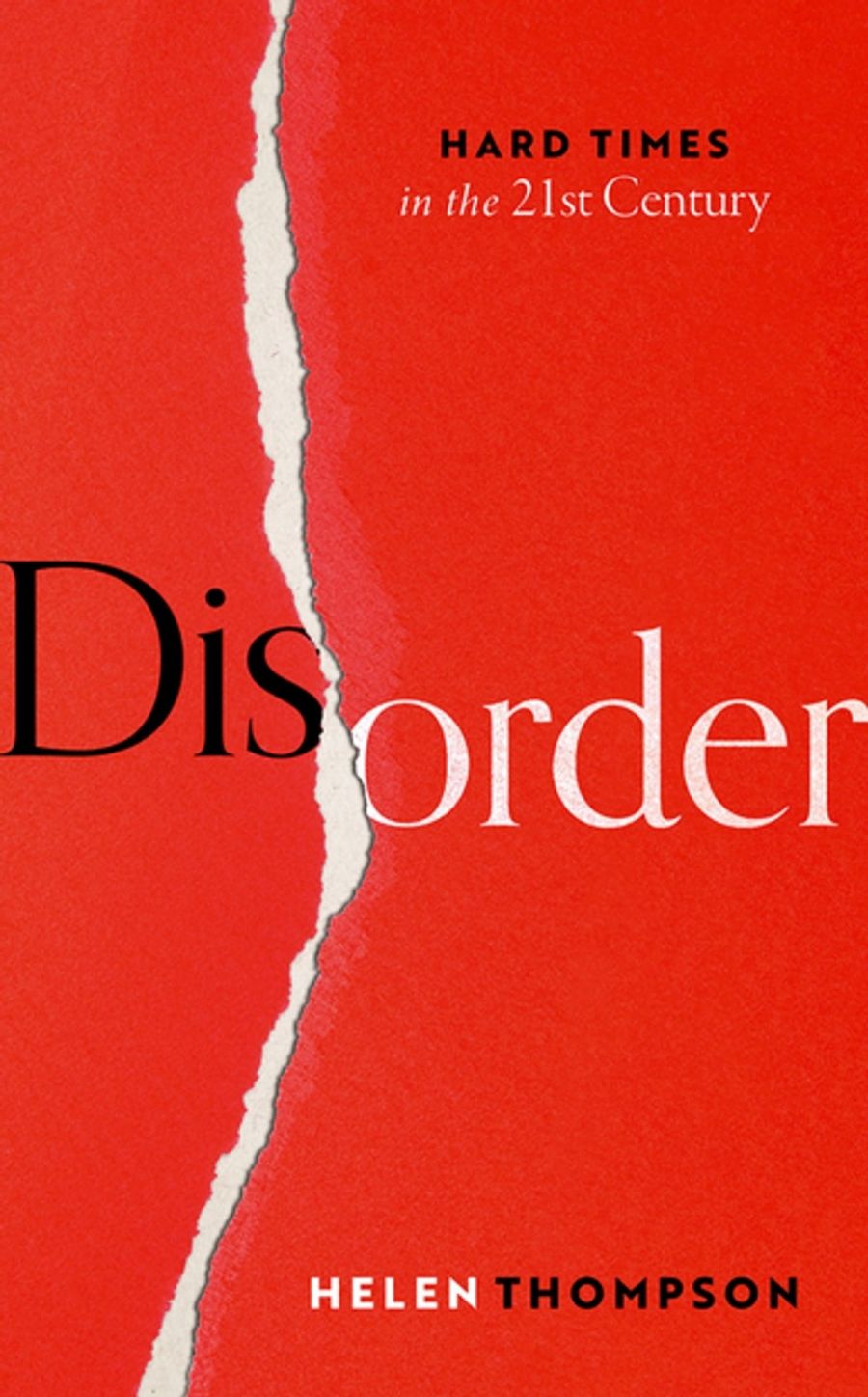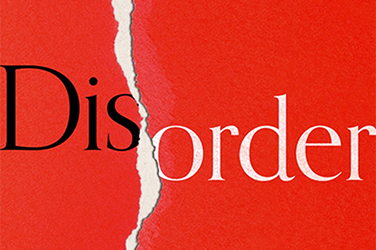
- Free Article: No
- Contents Category: History
- Review Article: Yes
- Article Title: Off balance
- Article Subtitle: The deep roots of our present moment
- Online Only: No
- Custom Highlight Text:
‘It’s a media beat-up,’ our Brooklyn Airbnb host assured me as we chatted on the doorstep one sparkling autumn afternoon in early November 2016. ‘They need to make it seem like a contest or there’ll be no story.’ It would have been rude for me, as an outsider, to demur. I bumped into him once more, ashen-faced the following morning, after Pennsylvania had finally swung to Donald J. Trump, delivering him the presidency. Our conversation was brief; his sense of disorientation palpable.
- Featured Image (400px * 250px):

- Alt Tag (Featured Image): Tim McMinn reviews 'Disorder: Hard times in the 21st century' by Helen Thompson
- Book 1 Title: Disorder
- Book 1 Subtitle: Hard times in the 21st century
- Book 1 Biblio: Oxford University Press, $43.95 hb, 384 pp
- Book 1 Readings Link: booktopia.kh4ffx.net/P0Z75Q
It was similar to how I’d felt in London five months earlier, the day after the United Kingdom had narrowly voted to leave the European Union. On the day of the referendum, I had taken my newborn son with me into the booth to cast a vote for ‘Remain’. I was confident that Jo Cox MP’s murder by a far-right activist shouting ‘Britain First!’ would repel people from voting Leave. This thinking was a mark of how little I and many others understood the forces that had brought the United Kingdom to that juncture. By the time of Trump’s election, I had been asking myself some questions that left me less surprised by that result.
After the political earthquakes of 2016, commentators erupted with accounts of what lay behind this apparent resurgence of populist nationalism. Yet this narrative, as well as talk of the ‘fall of the purportedly liberal international order’, is a profoundly misleading and ahistorical explanation of what went on, according to Helen Thompson in Disorder: Hard times in the 21st century. For Thompson, this is ‘not least because energy has largely gone unrecognized as an important cause of the geopolitical and economic fault lines’ present in the modern world. Energy (in particular, oil and gas) underpins modern material life, placing it at the core of the economic and political disruptions of the early twenty-first century: trade war and great power rivalry; populism and plutocracy; and the immense challenge of the energy transition.
Thompson makes her case by sketching three schematic, interlocking histories. The first is geopolitical. She charts the rise of oil as a replacement for coal for many energy uses. The importance of oil for the military and transportation – particularly shipping and aviation – made the control of reserves increasingly vital as the twentieth century progressed. Thompson’s sweeping narrative connects the collapse of the Ottoman empire, the Suez crisis, the rise of OPEC, Russian gas pipelines to Europe, the voracious growth in China’s energy demand, and the US shale boom. It covers this terrain less forensically than Dan Yergin in The New Map: Energy, climate and the clash of nations (2020), but Thompson’s geopolitical history, like Yergin’s, feels prescient as we experience the fallout from Vladimir Putin’s invasion of Ukraine.
The second history is economic, and its major preoccupations are the rise of the dollar system (in particular Eurodollars) and the monetary policy of the Federal Reserve and European Central Bank. In Thompson’s telling, the ebbs and flows of energy geopolitics undermine historical accounts of a liberal international economic order. Oil abundance and dollar power in the postwar moment laid the foundations for the creation of the Bretton Woods institutions which defined this order. But after Richard Nixon broke dollar–gold convertibility in 1971, it was Eurodollar markets and oil power (this time secured through military presence in the Persian Gulf and support for petrostates in the Middle East) that became the mainstays of American financial power. As Adam Tooze also recounted in the brilliant Crashed: How a decade of financial crises changed the world (2018), Eurodollar markets underpinned transnational bank funding and liquidity, creating the interdependences and financial plumbing that allowed the US subprime mortgage crisis to spread across the Atlantic. This set the stage for Europe’s banking and sovereign debt crises.
Thompson’s final history is about the effect time has on the stability of representative democracies, ‘as the geopolitical and economic conditions in which they were established change’. Thompson contends that the democracies in the United Kingdom, the United States, and the European Union are becoming unbalanced, not because of ‘democratic excess’ in the form of populist nationalism, but because of the growing power of plutocrats. This ‘aristocratic excess’, as she calls it, renders democracies harder to reform in the face of growing challenges. Thompson contrasts this with interwar and postwar concepts tying democratic nationhood to a collective economic fate. This diminishing sense of a shared destiny is undermining ‘loser’s consent’, a key source of the disruption of the last two decades.
Thompson deftly weaves together the telling of these three histories with magisterial command of her subjects. She holds herself at a distance from the minutiae of political events, and this is the great source of her book’s strength and insight. At the same time, her dry detachment is also a weakness, coming at the cost of animating the points of connection between energy, economics, and democratic political mechanics.
For example, at the end of her chapter on ‘democratic time’, Thompson looks back to the decades between the 1930s and 1960s when the United States was the world’s dominant oil producer. After a successful gambit by six oil-producing states to thwart Franklin D. Roosevelt’s effort to federally regulate the oil industry (which was then suffering an intense price slump), the Texas Railroad Commission emerged with the power to set global oil prices, providing the template for OPEC. This power elevated a raft of Texan political figures to the national stage, including Lyndon Baines Johnson.
This is a fascinating insight, but it gets little more than a footnote from Thompson. So much political colour and contingency is left unexplored, unlike in Robert Caro’s The Years of Lyndon Johnson: The path to power (1982), where the period is brought alive. Readers might recall Caro’s descriptions of campaigns financed by envelopes from Texas oilmen stuffed with bills and ‘legal fees’ entered into the books of Brown and Root, the construction firm of Herman Brown, a man who ‘wanted so fiercely to build big things’. Brown and Root would later be acquired by Halliburton Energy Services in 1962, which would become intimately bound up with the Bush dynasty.
Thompson does get closer to the political and economic intricacies of Brexit, but the perspective of Disorder, and rushed treatment, makes the event seem almost inevitable without much sense of the play of historical contingency. She describes how Britain became the ‘employer of last resort’ for Europe, ultimately hemming David Cameron into making the fateful commitment to a referendum on EU membership. In her telling, this situation arose through the conjunction of the EU’s freedom of movement rules and the relative inflexibility of the ECB’s monetary policy compared to the Bank of England’s, which enabled the UK to recover earlier from the 2007–8 crash and attracted migrants from Eastern Europe. No doubt this is true, and it gave me a new appreciation for the political pressure experienced by Cameron, but it’s too simple on its own. Thompson does not explore at all the tactical pressure exerted by the mercurial Nigel Farage’s exploitation of these conditions, or the Syrian refugee crisis.
Perhaps surprisingly (or not), this leaves Trump as the most enlivening figure throughout the book, though not for the usual reasons. As Thompson writes, although Trump’s theatrics drew outrage and censure, there was ‘little substantive criticism of using tariff pressure to try to reconstruct the US–China trade relationship or, crucially, making technological competition a matter of national security’. Trump is remembered for many things, but this new Washington Consensus may be one of his most significant legacies.
For a work with such an expansive reach, I am cautious of taking this line of critique too far. Her book could be a thousand pages long and still never do justice to the intricate mechanics of all the events she analyses. She acknowledges that even the major events that motivate her work – Brexit and Trump’s election – have their own particular stories which she does not have space to tell. Her aim is to sketch out the Big Picture, and taken on these terms, the book is enlightening. On balance though, perhaps a couple of carefully selected and illustrated stories would have helped to animate the structural forces she traces, and to reveal how they find purchase in political dynamics.
From an Australian perspective, the Atlantic focus of the work can seem remote. Australia’s experience of the years of Disorder has been shaped by our own region, particularly China’s economic response to the 2007–8 crash and increasingly muscular military stance. That’s not to mention two years of ‘fortress Australia’ during Covid. But as inflation sets in and we pursue a transition to net zero emissions, there is a real sense of bite to Thompson’s three histories, especially in the linkage between the economic and geopolitical. She offers no clear answers, but this work should help us ask the right questions to steer towards our future.


Comments powered by CComment